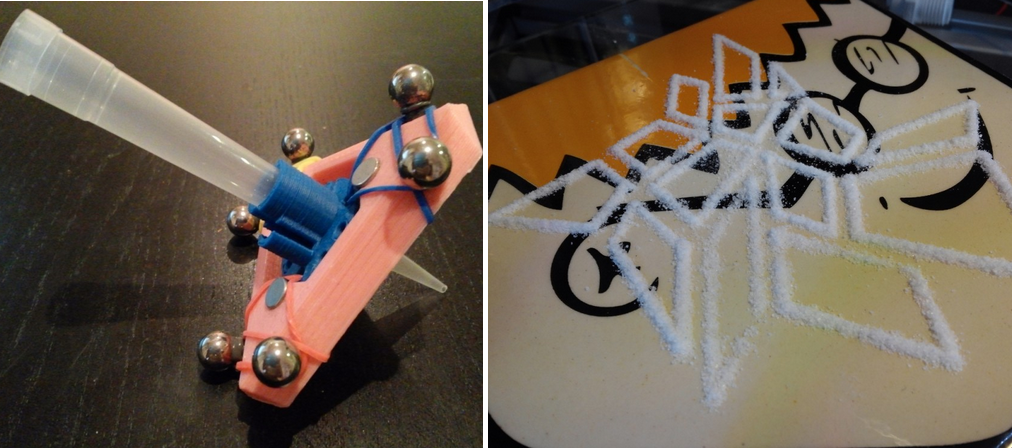 If you were to tell me five years ago that by 2015 we would be 3D printing food, I likely would have said that you were crazy. 2015 is certain to be a year of technological innovation. With technology progressing at an exponential rate, things which may have seemed like a pipe dream only a few years ago will likely become a reality. 3D printed food is one of these realities.
If you were to tell me five years ago that by 2015 we would be 3D printing food, I likely would have said that you were crazy. 2015 is certain to be a year of technological innovation. With technology progressing at an exponential rate, things which may have seemed like a pipe dream only a few years ago will likely become a reality. 3D printed food is one of these realities.
Although it may take a while for society to fully accept food being prepared from a machine, by the end of the year companies like 3D Systems, with their ChefJet Printer, and Natural Machines, with their Foodini 3D printer, will take the technology to the next level.
If you are at all interested in the space where food meets digital fabrication, then you may have stumbled upon the website called 3Digital Cooks. Dedicated to providing news, information, and recipes related to the 3D printing of tasty treats, 3Digital Cooks has set out to achieve a goal of merging the digital and food worlds, while sharing and creating new ideas.
One of these ideas is a dry food 3D printer. We all know how important texture is to a meal. I personally find the texture of a food just as  important as its taste. This is why food printers scare me a bit. Most of what we have seen thus far are machines with extrude paste-like substances: mashed potatoes, cookie dough, peanut butter, and the like. What about mixing different textures or printing more coarse foods? Up until now, besides 3D Systems’ ChefJet, which actually sprays water out onto a bed of sugar, this has not been possible, at least not in an affordable setup.
important as its taste. This is why food printers scare me a bit. Most of what we have seen thus far are machines with extrude paste-like substances: mashed potatoes, cookie dough, peanut butter, and the like. What about mixing different textures or printing more coarse foods? Up until now, besides 3D Systems’ ChefJet, which actually sprays water out onto a bed of sugar, this has not been possible, at least not in an affordable setup.
3Digital Cooks has set out on this mission without a ton of cash to work with.
“So far the powder extruder is an experiment with just a couple of attempts. The idea behind it is to try to print food in other forms a part from pastes/purees,” explained 3Digital Cooks to 3DPrint.com. “For us at 3DC it is not about switching from paste to powders. It is about learning new printing methods that, as a long term project, can be combined.”
They started by 3D printing most of the main components for the dry material extruder. At the center of the 3D printed extruder is a pipette tip attached to a holder. Initially the team decided to use a single motor which vibrates the pipette tip, allowing for the release of a dry material like sugar.
After finding that the pipette tip would clog after a few seconds of printing, they decided that they needed more power. They replaced the single motor with 3 motors, equating to more movement and, thus, less clogging.
“[The extruder] currently functions with the same vibration motors that cellphones have in them. The way it works is that when the motors are on, the powder reservoir shakes, making the powder particles ‘crash’ [into] each other, freeing some space in between that helps them ‘flow'”, explained 3Digital Cooks.
After attaching the extruder to a Delta 3D printer, the team tested the new device. To their satisfaction the three motors worked wonders, allowing a steady flow of the granular material out of the extruder head, as you can see in the video at the bottom of this page.
“The goal for the powder extruder is to consistently print powders. Sugar, chocolate, spices, and hopefully adding a bigger hopper,” explained 3Digital Cooks.
There is still a long way to go before complex designs and the possibility of mixing dry and wet ingredients can take shape; however, this accomplishment should provide yet another step toward affordable home food printers as we enter 2015.
Are you interested in the progress of dry food printing? Let us know what you think about this process at the 3Digital Cooks Dry Food 3D Printer forum thread at 3DPB.com.

Subscribe to Our Email Newsletter
Stay up-to-date on all the latest news from the 3D printing industry and receive information and offers from third party vendors.
You May Also Like
Nylon 3D Printed Parts Made More Functional with Coatings & Colors
Parts 3D printed from polyamide (PA, Nylon) 12 using powder bed fusion (PBF) are a mainstay in the additive manufacturing (AM) industry. While post-finishing processes have improved the porosity of...
3DPOD Episode 193: Flow and What’s Possible in 3D Printing with Ricky Wildman, University of Nottingham
Ricky Wildman is working on 3D printing pills, but, as Professor of Multiphase Flow and Physics at Nottingham, he does a whole lot more. His research encompasses the characterization of...
3D Printing Webinar and Event Roundup: March 17, 2024
It’s another busy week of webinars and events, including SALMED 2024 and AM Forum in Berlin. Stratasys continues its in-person training and is offering two webinars, ASTM is holding a...
3D Printed Micro Antenna is 15% Smaller and 6X Lighter
Horizon Microtechnologies has achieved success in creating a high-frequency D-Band horn antenna through micro 3D printing. However, this achievement did not rely solely on 3D printing; it involved a combination...






























